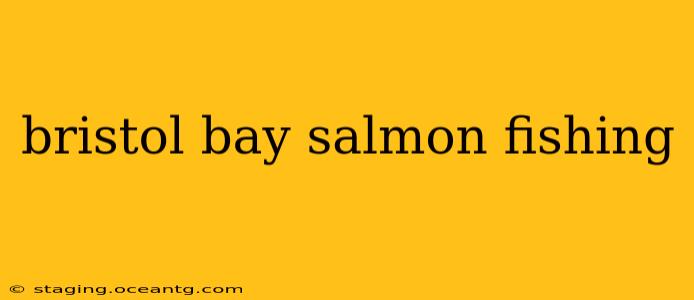Bristol Bay, located in southwest Alaska, is renowned worldwide as a premier salmon fishing destination. Its pristine waters teem with five species of Pacific salmon—chinook (king), sockeye (red), chum (dog), coho (silver), and pink—attracting anglers from across the globe. This bay isn't just about catching fish; it's about experiencing the raw beauty of Alaska, immersing yourself in a rich fishing culture, and respecting a delicate ecosystem. This comprehensive guide explores everything you need to know about Bristol Bay salmon fishing.
What Makes Bristol Bay Salmon Fishing So Special?
Bristol Bay's unparalleled reputation stems from several factors:
- Abundance of Salmon: The sheer number of salmon returning to spawn each year is staggering. This abundance contributes to exceptional fishing opportunities, making it a truly remarkable experience for anglers of all skill levels.
- Wild Salmon Runs: The salmon here are wild, meaning they haven't been subjected to the stresses of hatcheries or farming practices. Their fight is legendary, and their quality is unsurpassed.
- Unspoiled Wilderness: Bristol Bay's vast and largely undeveloped landscape adds to its allure. The remote location provides a truly immersive wilderness experience, far removed from the hustle and bustle of modern life.
- Diverse Fishing Methods: Anglers can employ various methods, from drift fishing and trolling to casting and fly fishing, catering to diverse preferences and skill sets. Each method offers unique challenges and rewards.
- Variety of Salmon Species: The presence of all five Pacific salmon species allows for a diverse fishing experience, with each species presenting unique challenges and rewards in terms of fishing techniques and fighting prowess.
What are the best times to go salmon fishing in Bristol Bay?
The optimal time for Bristol Bay salmon fishing depends heavily on the specific species you're targeting:
- Sockeye Salmon: The peak of the sockeye run typically occurs in July, though the timing can vary slightly from year to year.
- Pink Salmon: Pink salmon runs usually peak in odd-numbered years during the months of July and August.
- Chinook Salmon: Chinook salmon fishing opportunities extend from June through August, with peak times often falling in the middle of the season.
- Chum Salmon: Chum salmon runs generally occur in late summer and early fall, primarily in August and September.
- Coho Salmon: Coho salmon are usually most abundant in August and September, though their presence may extend into October.
Understanding these peak seasons allows you to plan your trip strategically for the specific species you want to pursue.
What kind of gear do I need for Bristol Bay salmon fishing?
The essential gear for Bristol Bay salmon fishing includes:
- Rods and Reels: Sturdy rods and reels capable of handling larger salmon are essential. The specific type will depend on your chosen fishing method.
- Line: Use strong braided line, suitable for the size of salmon you are targeting.
- Hooks: Select appropriate sized hooks for the species you are targeting. Using the correct size ensures safe handling and release of the fish.
- Weights and Lures: Your lure choice will depend on your preferred fishing method and the type of salmon.
- Waders or a Boat: Accessing optimal fishing locations often requires wading or using a boat.
- Appropriate Clothing: Alaska's weather can be unpredictable; pack layers of clothing to accommodate changing conditions. Rain gear is a must.
- Safety Gear: Always prioritize safety with a life vest, and appropriate safety gear for your vessel if boating.
How much does a guided trip to Bristol Bay cost?
The cost of a guided fishing trip to Bristol Bay can vary significantly depending on factors such as the length of the trip, the type of accommodation, the number of anglers, and the specific services included. Expect to pay a substantial amount, reflecting the remote location, high-quality guiding services, and the overall exclusivity of the experience.
What is the best way to get to Bristol Bay for fishing?
Accessing Bristol Bay typically involves air travel, usually to smaller airports near fishing lodges or charter operations. Most anglers fly into Anchorage (ANC) and then take connecting flights to smaller airports closer to their fishing destination.
What are the regulations for salmon fishing in Bristol Bay?
Fishing regulations in Bristol Bay are strictly enforced to ensure sustainable fishing practices and protect the valuable salmon runs. It's crucial to thoroughly familiarize yourself with the current regulations before your trip. These regulations change annually, so always check with the Alaska Department of Fish and Game (ADF&G) for the most up-to-date information.
Conclusion:
Bristol Bay salmon fishing presents an unparalleled opportunity for anglers to experience the thrill of catching wild salmon in a pristine wilderness setting. By planning carefully, understanding the regulations, and selecting the right gear, you can embark on an unforgettable adventure. Remember to respect the environment and adhere to responsible fishing practices to ensure the longevity of this remarkable fishery.
